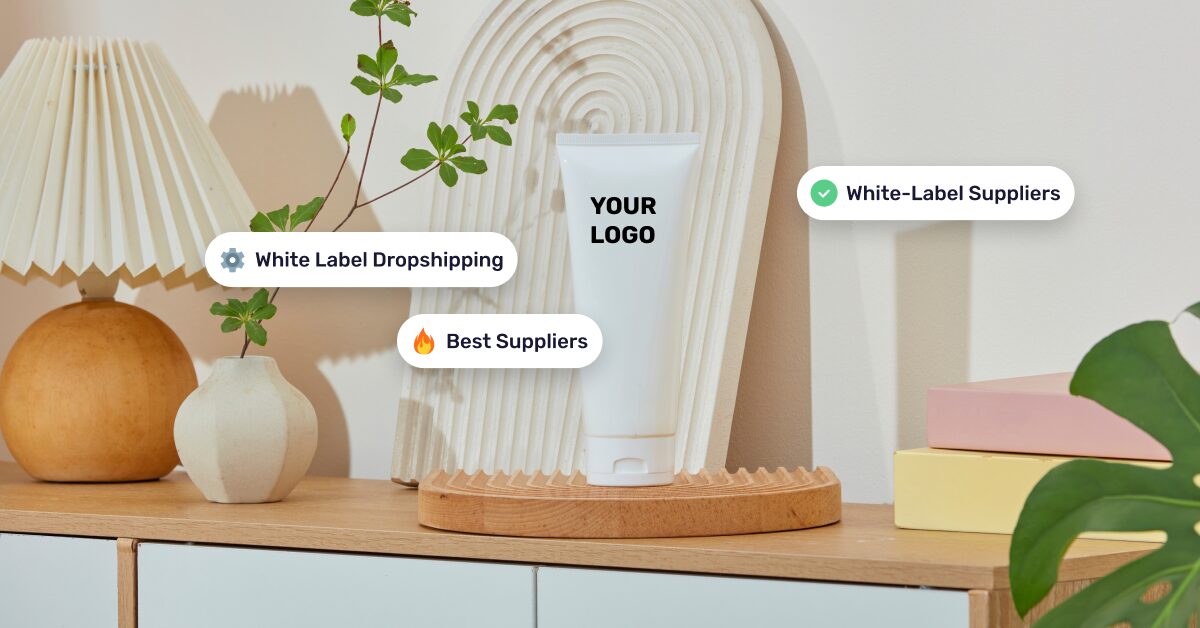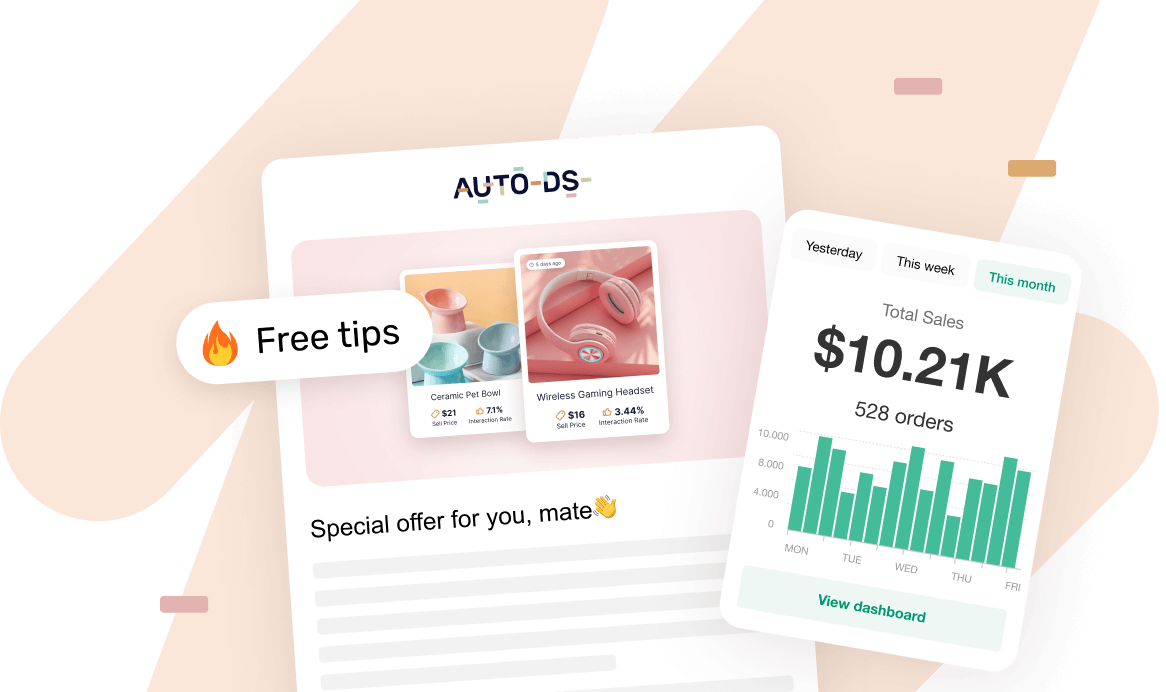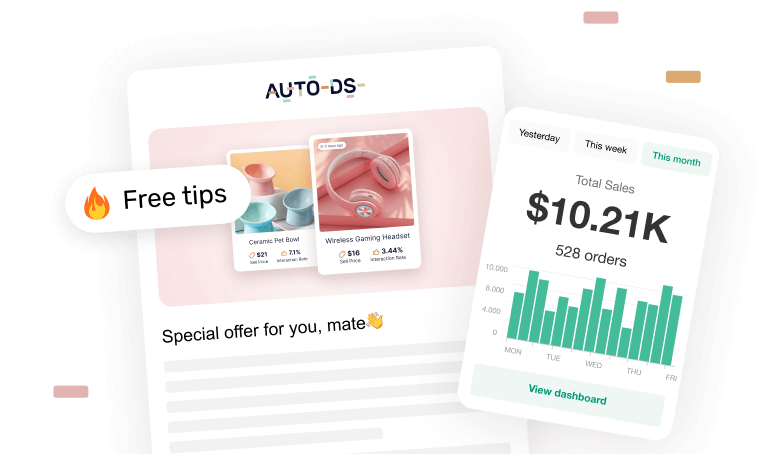Have you ever dreamed of launching your own brand (logo, vibe, you know, the whole thing) without ever touching a factory or warehouse? Well, white label dropshipping will make that dream a reality in 2025 (and beyond).
As eCommerce evolves, so does the way shoppers connect with brands. Generic, one-size-fits-all stores are fading out. In their place? Branded experiences that feel personal, trustworthy, and professional, even if they’re powered by dropshipping behind the scenes. Meanwhile, tools like AutoDS offer built-in automation, branding support, and real-time inventory syncing, helping sellers transform basic storefronts into credible, consistent brands.
White label dropshipping is perfect for beginners eager to launch quickly and for experienced sellers aiming to stand out in crowded markets. It’s cost-effective, flexible, and with the right setup, surprisingly simple. In this guide, we’ll show you how it works and how to turn it into a business that actually sticks.
White label dropshipping lets sellers rebrand ready-made products, remaining a smart, low-barrier model in today’s eCommerce.
Its downsides, like limited customization or high competition, are outweighed by fast launches, low costs, and easy scalability.
Private label dropshipping differs by offering full product control, but requires more time, investment, and coordination.
With the right strategies (niche research, branding, supplier vetting) white label stores can stand out in crowded markets.
Automation tools like AutoDS simplify product imports, order fulfillment, and price monitoring, saving time and avoiding errors, making them key to running this model efficiently.
In 2025, white label dropshipping offers a flexible, cost-effective path to building a brand and running a sustainable online business.
What Is White Label Dropshipping?
First things first: white label dropshipping is a model where you sell generic products under your own brand, without ever manufacturing a thing. The supplier takes care of production and shipping, while you focus on what really matters: branding, selling, and building customer loyalty. Unlike generic dropshipping, where you’re just reselling someone else’s product as-is, white labeling lets you own the brand experience.

Let’s bring it down to earth with some examples. Ever bought a stylish water bottle with a logo from a fitness influencer? Chances are, it was a white-label product. Same goes for many cosmetics and skincare brands (like Kylie Cosmetics and ColourPop, both produced by the same manufacturer, but branded and marketed differently).
Even mugs, phone cases, or dog toys can be white-labeled and turned into unique store offerings. The product stays the same, but the story around it is all yours.
Light White Labeling vs. Full White Labeling
Not all white labeling is created equal. Here’s how it breaks down:
- Light White Labeling: This involves applying minimal customization, usually by adding your logo to an existing generic product. Think of mugs, tumblers, or phone cases rebranded with your name. It’s a fast, low-risk way to test demand and validate your niche.
- Full White Labeling: This takes branding a step further by including custom packaging, branded inserts, personalized labels, and even slight design tweaks. It creates a more premium customer experience and helps build stronger brand recognition over time.
Whether you go light or full depends on your vision and resources. Either way, you’re moving from just selling products to building a brand that sticks.
Is White Label Dropshipping Worth It?
In a word? Absolutely. The dropshipping market keeps evolving, valued at $365.7 billion in 2024 and projected to exceed $1.2 trillion by 2030. As online shopping grows, white label dropshipping stands out as one of the most accessible, brand-driven ways to launch and scale a business, especially for sellers who understand the power of branding.
With low startup costs and the ability to price products at a premium, this model offers a scalable path to building a real business without managing production or inventory. The key? You have to stand out.
In 2025, it’s no longer about simply selling products; it’s about building a brand. Sellers are shifting away from generic listings and leaning into brand identity to foster trust and repeat purchases. Meanwhile, automation and AI are making backend operations leaner, and trends like eco-friendly consumption and niche targeting are creating new spaces to grow. Add social commerce via TikTok and Instagram, and it’s clear why this model keeps gaining ground.
Like any business, white label dropshipping has its ups and downs. Here’s a quick look at both sides:
✅ Pros:
- Low Startup Costs: No need to invest in manufacturing or inventory upfront.
- Branding Power: A custom brand builds trust and loyalty, letting you charge more.
- Scalability: You can add new products easily without major overhead or logistics stress.
- Higher Profit Potential: Branded products increase perceived value (and margins).
- Flexibility: It lets you run your store from anywhere while suppliers handle fulfillment.
⚠️ Cons:
- Supplier Dependence: Your brand’s reputation hinges on supplier reliability.
- Market Saturation: Standing out in competitive niches takes real strategy.
- Upfront Branding Costs: Custom packaging or labels require some investment.
- Legal Risks: You’re responsible for compliance, safety, and honest marketing.
Common Risks and How to Overcome Them
White label dropshipping isn’t risk-free. The good news? Most challenges are manageable (and even avoidable) with the right mindset, tools, and strategies.
- Unreliable Suppliers: Delays, errors, or out-of-stock issues can hurt your brand. ➡️ Vet suppliers carefully, order samples, set clear expectations, and monitor performance consistently. Tools like AutoDS help by tracking stock and price changes across trusted suppliers, keeping your listings accurate and your customer experience smooth.
- Market Saturation: Too many sellers in one niche can shrink your margins. ➡️ Stand out with a niche focus, strong branding, and a unique offer. A/B testing and automation let you adjust faster and more efficiently.
- Shipping Delays: Long delivery times frustrate customers and hurt repeat sales. ➡️ Choose suppliers with local warehouses and offer realistic shipping estimates. Automation platforms make it easier to filter them by region and set up fallback options.
- Legal & Compliance Risks: You’re responsible for safety standards and marketing claims. ➡️ Verify that your suppliers follow regulations and seek advice when needed. Using the right backend tools helps keep listings up to date and reduces risk from inaccurate info.
- Upfront Branding Costs: Custom packaging and labels can eat into your budget early on. ➡️ Start lean with a focused product range, track ROI (return on investment) closely, and scale as profits grow. Automating operations lets you save on time and costs, so you can invest more in brand-building.
How Does White Label Dropshipping Work?
As we’ve seen, white label dropshipping works by combining the strengths of suppliers and sellers to deliver branded products without the hassle of inventory management.
Behind the scenes, suppliers produce and stock generic items, then handle order fulfillment and shipping directly to customers. This setup allows sellers to focus on marketing and growing their brand.
From the customer’s perspective, branding comes through packaging, logos, and personalized touches like inserts or communication, creating a unique shopping experience despite the product itself being made by a third party.
Still, there are limits to customization: product design and features usually stay the same, with branding mainly limited to packaging and labels. This means sellers create a branded experience but don’t have full control over the product itself.
White Label Dropshipping Vs. Private Label Dropshipping
By now, you know white label dropshipping is about selling ready-made products under your own brand: customizing packaging, adding a logo, and focusing on marketing while the supplier handles the rest.
But there’s another route: private label dropshipping. In this model, the supplier manufactures products exclusively for your brand, often based on your specific requirements (be it ingredients, design, or packaging). You’re not just branding a generic product; you’re shaping a unique one from the ground up.
The core difference comes down to control and customization. With white labeling, you move faster and keep costs low, but you’ll likely be competing with other sellers offering the same product. It’s ideal for testing products, launching quickly, or operating in trend-sensitive niches where branding is what sells.
Private labeling, on the other hand, gives you exclusive products and full creative input, reat for long-term brand building. It does require more time, money, and coordination (also risks), so it’s better suited for entrepreneurs ready to commit to product development and brand differentiation from the start.
Each model has its own strengths and trade-offs. Here’s how they stack up:
Pros & Cons Of White Label Dropshipping
✅ Pros:
- Low Startup Costs: White label dropshipping lowers entry barriers by removing the need for inventory or manufacturing.
- Fast Time-to-Market: It speeds up product launches by allowing sellers to list existing items with light branding.
- No Minimum Orders: Most suppliers allow single-unit fulfillment, so you can test without big commitments.
- Basic Branding Options: Simple touches like logos or packaging tweaks help build a recognizable brand.
- Easy Scalability: Adding new products or switching suppliers is quick and doesn’t require complex logistics.
❌ Cons:
- Limited Customization: White label dropshipping restricts product uniqueness by offering minimal creative control.
- High Competition: Many sellers offer the same items, making differentiation harder
Pros & Cons Of Private Label Dropshipping
✅ Pros:
- Exclusive Products: Private label dropshipping boosts item exclusivity by letting sellers customize specifications and design.
- Full Branding Control: From the packaging to the product itself, every detail reflects your identity.
- Product Quality Input: Working directly with manufacturers lets you influence materials and standards.
❌ Cons:
- Higher Upfront Costs: Private label dropshipping increases startup investment by requiring product development and custom packaging.
- Slower Launch Times: Creating a unique product takes time, from prototyping to production.
- Minimun Order Quiantity Requirements: It often includes MOQ requirements, forcing sellers to purchase a minimum quantity of units before launch.
- Supplier Sourcing Difficulty: Private label dropshipping adds complexity by making it harder to find reliable, specialized suppliers.
- Ongoing Brand Management: Ongoing coordination is needed to maintain brand quality and consistency.
How To Start White Label Dropshipping – 6 Simple Steps
Alright, now it’s time to take action. These six simple steps will help you add white-label products to your dropshipping store and grow a successful business. From picking the right niche to marketing your products, you’ll get a clear roadmap to follow.
Step 1: Choose a Profitable Niche
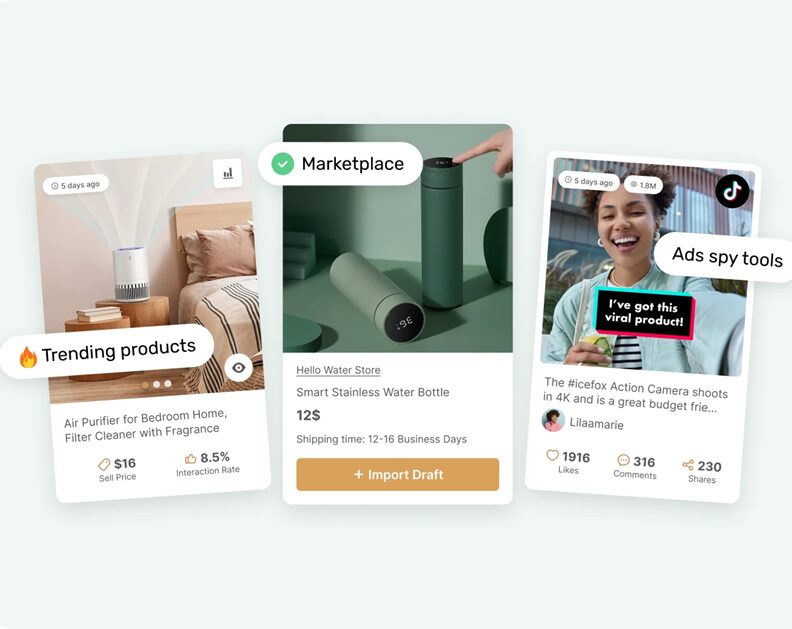
When it comes to white label dropshipping, starting with products that are already in demand gives you a big advantage. The first step is doing solid product research to understand what customers really want. By studying market trends, you can find profitable dropshipping niches that fit your goals.
A great place to begin is the Product Finding Strategies section on the AutoDS dropshipping blog, which offers practical tips for your research. Once you’re ready to dive deeper, tools like the AutoDS product research tool make it easy to spot trending items and evaluate their potential. Using these resources will help you pick a niche where you can thrive.
🔍 Research Tip: Use AutoDS’s Ads Spy Tool to analyze viral products and see what’s working across TikTok, Facebook, and Instagram.
Step 2: Find the Right White Label Supplier
Once you’ve chosen your niche, the next step is finding a supplier you can trust. The right partner can make or break your customer experience, so it’s worth getting this right from the start. Here’s what to look for when evaluating suppliers:
- MOQs (Minimum Order Quantities): Some suppliers require bulk orders. Choose one that offers low or no MOQs if you’re starting small.
- Branding Options: Check if they support custom logos, thank-you cards, or branded invoices, which are essential for creating a consistent brand experience.
- Shipping Times: Fast, reliable shipping (especially from local warehouses) keeps customers happy and reduces refund requests.
- Product Variety: Suppliers with a broad catalog let you scale easily within your niche.
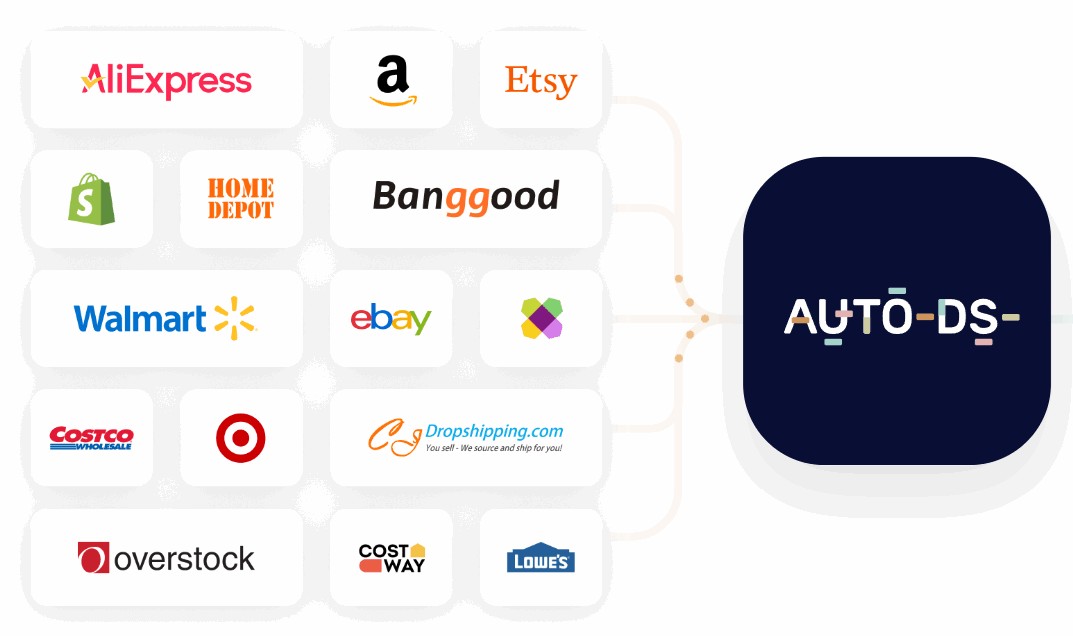
There are plenty of directories and platforms to help you get started. Here are some of the most popular and white-label-friendly options:
AutoDS
AutoDS connects dropshippers with vetted suppliers, automates store operations, and enables branding on select products, all in one platform. With over 30 suppliers, a product research hub, and built-in tools like Ads Spy, it simplifies both sourcing and scaling.
CJDropshipping
CJdropshipping offers private label services, global warehouses, and customization features for many products. Great for sellers looking to scale internationally while maintaining branding control.
Overstock
Overstock is known for home goods and decor, with opportunities to rebrand quality products. It’s ideal for niche stores in the furniture or interior design space looking for stylish, ready-to-ship items.
Banggood
Banggood offers a large variety of electronics, tools, and lifestyle products with global shipping support. It’s especially popular for tech and gadget niches and has solid integration with automation tools.
Wayfair
Wayfair specializes in home and furniture, ideal for white labeling in the home decor niche. With a vast selection of products and low-cost two-day shipping on all US orders, it’s a useful source and potential wholesale partner for curated product lines.
Costway
Costway offers appliances and furniture with dropshipping options and broad product categories. It’s a good match for sellers aiming at higher-ticket home items or niche furnishings.
Amazon
Amazon stands out as a reliable source for trending, fast-shipping items, especially useful when paired with automation tools like AutoDS. Great for testing trending products with faster domestic delivery.
📦 Supplier’s Tip: Always request product samples before committing. This lets you check product quality, shipping speed, and packaging firsthand—so you know exactly what your customers will receive.
Step 3: Set Up Your Store

Now that you’ve locked in your niche and supplier, it’s time to build your storefront, the digital home for your brand. Start by choosing the right platform for your goals:
- Shopify: A user-friendly, all-in-one solution ideal for beginners and scaling brands alike. Offers tons of apps, themes, and built-in dropshipping integrations.
- Wix: Great for design flexibility with drag-and-drop functionality. Perfect if you want full control over your store’s visual identity.
- WooCommerce: A WordPress plugin that gives advanced users maximum control and customization. Best suited if you’re comfortable managing hosting and plugins.
- eBay: A strong option for reaching a large, built-in audience. Ideal for sellers looking to test products and gain early traction.
- Facebook Marketplace: A zero-cost, fast-moving platform with local and national reach, great for beginners or those validating new products.
Once you’ve picked your platform, it’s time to build your storefront. The goal here is to earn trust at first glance. Use a clean, easy-to-navigate layout that smoothly guides visitors from homepage to checkout. Include trust signals like product reviews, clear shipping and return policies, and contact info to reassure buyers you’re legit.
Add basic brand elements like a logo, consistent colors, and clear product descriptions to give your store a polished look (we’ll dive deeper into branding and premium touches in the next step).
Step 4: Customize Branding Elements
White label dropshipping may start with a generic product, but how you present it can make all the difference. To build a memorable brand, start with the essentials:
- Logo & Color Palette: Create a clean, consistent logo and choose 2–3 brand colors. These will show up on your packaging, storefront, and social media.
- Store Design: Your storefront is often the first impression. Use your branding across banners, fonts, product images, and icons to build a cohesive experience.
- Product Packaging: While not all suppliers offer custom packaging, some allow thank-you cards or branded invoices—small details that leave a lasting impression.
- Branded Inserts: Include discount codes, thank-you notes, or QR codes linking to your socials. It turns a basic unboxing into a brand moment.
But branding doesn’t stop at checkout:
- Order Confirmation & Emails: Customize your post-purchase messages to reflect your voice and values.
- Packaging & Delivery: Even if the outer box is generic, a personalized insert or card goes a long way in creating a exclusive feel.
💡Pro Tip: Focus on storytelling to make it feel premium. Use consistent messaging, clean design, and small branded touches to elevate your brand, no fancy packaging required.
Step 5: Automate Your Processes

As your white label business grows, doing everything manually becomes unsustainable. That’s where automation steps in, saving time, reducing mistakes, and helping you scale faster.
AutoDS offers a full suite of automation tools designed to handle the backend for you, so you can focus on branding, marketing, and growing your business. Here’s what automation with AutoDS can do:
✅ Product Importing: Quickly import product details (including images, descriptions, and variants) from your white label supplier’s site. With AutoDS, it takes one click to list new products.
✅ Inventory Syncing & Price Monitoring: AutoDS tracks stock levels and price changes in real time. If your supplier runs out or adjusts prices, your store updates automatically, avoiding overselling or profit loss.
✅ Order Fulfillment & Tracking: When you get a sale, AutoDS places the order with your supplier and sends tracking updates to your customer completely hands-free.
✅ Bulk Product Management: Managing a large catalog? AutoDS lets you edit, optimize, or remove multiple listings at once, so you stay organized while scaling.
✅ Smart Pricing & Profit Tracking: AutoDS calculates your profit margins and can auto-adjust prices based on rules you set, keeping you profitable, even when supplier costs change.
In short? AutoDS automates the busywork so you can focus on building a brand, not just managing a store. For white label dropshippers aiming to scale efficiently, it’s not just a time-saver: it’s a game-changer.
Ready to take your white label business to the next level? Try AutoDS’s 14-day trial for $1 and see how much smoother dropshipping can be.
Step 6: Launch & Market Your Products

You’ve got your products, your store, and your branding: now it’s time to get noticed.
White label marketing isn’t just about driving traffic. It’s about telling a cohesive brand story that makes your version of a product feel more valuable than the rest. Since you’re selling items others may offer too, your edge lies in how you position and promote them.
Here are a few ways to market your white-label store effectively:
- Run Paid Ads: Start small with Facebook, TikTok, or Google Ads to test what works. Use eye-catching visuals and focus your messaging on what makes your product or brand stand out.
- Partner with Micro-Influencers: Influencers with niche, engaged audiences can give your brand instant credibility, especially when you’re just starting out. A gifted product and a short review can work wonders early on.
- Build an Email List: Use pop-ups and first-order discounts to collect emails from day one. Follow up with product drops, restocks, and brand updates to keep customers engaged.
The most important thing? Craft a clear value proposition. At the end of the day, it all comes down to what makes your version of the product different. Maybe it’s your brand voice, eco-friendly packaging, or a better customer experience. Whatever it is, highlight it clearly in your ads, product pages, and social media.
Common White Label Dropshipping Mistakes to Avoid
White label dropshipping offers serious branding potential, but only if you treat it like a real brand. Many new sellers fall into the trap of approaching it like generic dropshipping, missing key opportunities to stand out. Here are some common mistakes to steer clear of:
- Treating It Like Generic Dropshipping: Using white label products without proper branding defeats the purpose. Slapping on a logo isn’t enough: your storefront, packaging, and marketing should all reflect a cohesive brand experience.
- Skipping Sample Orders: If you don’t test the product yourself, you’re risking customer disappointment. Always order samples before selling to check quality, packaging, and delivery times.
- Not Defining a Clear Niche: Selling everything to everyone rarely works. White label success depends on niche focus. Know your audience, their values, and what makes your product relevant to them.
- Choosing Suppliers Without Branding Options: Not all suppliers offer custom packaging or inserts. Make sure to work with those who do; otherwise, you’ll lose out on one of the biggest benefits of white labeling.
Tips to Boost Your White Label Dropshipping Business
Once your store is up and running, it’s time to fine-tune. These small but powerful tweaks can help elevate your brand, build customer trust, and keep sales growing over time:
- Optimize Your Product Pages and Copy: Great branding falls flat without clear, persuasive copy. Write benefit-focused descriptions, use high-quality images, and make your value proposition obvious at a glance.
🆕Beginner’s Tip: Use AutoDS’s AI product title & description generator to quickly create compelling, SEO-friendly copies that helps your products stand out.
- Maintain Strong Supplier Relationships: Communication is everything. Build trust with your suppliers to stay ahead of stock issues, improve fulfillment speed, and access branding perks like inserts or custom invoices.
- Monitor Performance and Adapt: Track what’s working, from ad performance to customer reviews. Use the data to tweak pricing, update descriptions, or swap underperforming products before they drag you down.
- Build a Brand Voice, Even with Limited Customization: You don’t need full product control to stand out. Use your tone, visuals, emails, and social media to craft a recognizable personality that connects with your audience.
Frequently Asked Questions
Can I start with no money?
Yes, you can start white label dropshipping with little to no money. Free platforms and organic marketing help reduce upfront costs, but you’ll need a way to pay suppliers after receiving orders. Starting lean with one product and simple branding lets you test the waters with minimal risk.
What’s the difference between white-label and print-on-demand?
The main difference is that white label dropshipping sells generic products under your brand, while print-on-demand creates custom-designed items only after an order. In a few words: POD focuses on made-to-order designs; white label focuses on rebranding existing products.
Do I need to register a brand?
No, you don’t need to register a brand to start white label dropshipping, but it’s highly recommended. Registration builds trust, protects your identity, and unlocks branding features as your business grows. It becomes increasingly important as you scale and want to protect your name across platforms.
What are the best white-label niches?
The best white label niches in 2025 include fitness gear, pet products, eco-friendly items, skincare, phone accessories, health foods, and home decor, high-demand spaces with branding potential and repeat buyers. Our recommendation? Choose a niche that fits your audience and allows for emotional connection, repeat sales, or strong visual branding.
Final Thoughts: Should You Start a White Label Business in 2025?
If you’ve made it this far, you probably already know the answer. Yes: with low startup costs, fast launches, and great branding potential, white label dropshipping remains one of the smartest ways to build a scalable ecommerce business today.
While customization limits product uniqueness, smart branding, automation, and marketing can set you apart in competitive niches. AutoDS helps sellers automate tasks, manage suppliers, and focus on branding, making it easier than ever to stand out and grow. Doing this, you can create a profitable business that meets modern consumer expectations.
So, if you’re looking for a business model that balances simplicity with branding potential, white label dropshipping is definitely worth a try.
Want to keep learning? For more tips on dropshipping success, check out our related articles:






